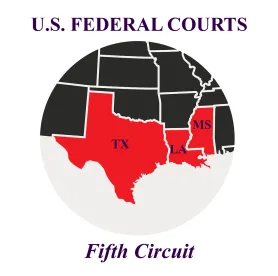Is the COVID-19 pandemic a “natural disaster” for purposes of the notice exception of the Worker Adjustment and Retraining Notification (WARN) Act?
“No,” says the first federal appeals court to rule on the issue.
The U.S. Court of Appeals for the Fifth Circuit has held that the COVID-19 pandemic is not a natural disaster and does not excuse an employer from providing notice before implementing a mass layoff or a plant closing. Easom v. US Well Services, Inc., No. 21-20202 (5th Cir. June 15, 2022).
The Fifth Circuit has jurisdiction over Louisiana, Mississippi, and Texas.
WARN Act Notice Requirement
The federal WARN Act (29 U.S.C. § 2101 et seq.) requires covered employers to provide written notice at least 60 days before implementing a “plant closing” or a “mass layoff.”
Under WARN, a “plant closing” is the permanent or temporary shutdown of a single site of employment or one or more facilities or operating units within a single site of employment where the shutdown results in an “employment loss” during any 30-day period for at least 50 full-time employees.
A “mass layoff” is a reduction in force which is not a plant closing and results in an employment loss at a single site of employment during any 30-day period for at least 50 full-time employees who constitute at least 33 percent of active full-time employees at that single site of employment or where 50 or more full-time employees at a single site of employment suffer employment losses during a 30-day period.
An “employment loss” is an involuntary termination (other than a discharge for cause, voluntary departure, or retirement), a layoff exceeding six months, or a reduction in work hours of more than 50 percent, during each month of any six-month period.
Three exceptions to the 60-day notice requirement exist, permitting an employer to provide fewer than 60 days of notice as soon as practicable and with an explanation as to why it reduced the notice period. The Department of Labor’s (DOL) WARN Act regulations provide that an employer that relies on any of these exceptions as a justification for providing fewer than 60 days of notice bears the burden of proving that it met the specific exception(s) requirements and that it provided as much notice as is practicable. The “faltering company” exception is available only for a plant closing while the “unforeseeable business circumstances exception” and the “natural disaster” exception may be available both for a plant closing or a mass layoff.
While the WARN Act statute expressly provides, “No notice under this chapter shall be required if the plant closing or mass layoff is due to any form of natural disaster, such as a flood, earthquake, or the drought currently ravaging the farmlands of the United States,” the WARN regulations expressly require that an employer provide notice, albeit reduced or after the fact, of a plant closing or a mass layoff due to natural disaster. The WARN Act regulations go on to state, “Floods, earthquakes, droughts, storms, tidal waves or tsunamis and similar effects of nature are natural disasters ….” The WARN Act regulations further instruct, “To qualify for this exception, an employer must be able to demonstrate that its plant closing or mass layoff is the direct result of the natural disaster.”
COVID-19 Conundrum
The few federal courts to consider whether the COVID-19 pandemic is a natural disaster for purposes of the WARN Act’s natural-disaster exception have been split. The only such case previously to have made its way to a federal appeals court is Benson v. Enterprise Leasing Co., No. 21-11911 (11th Cir. Oct. 25, 2021).
In Benson, a rental car company initiated layoffs at its airport locations in Orlando and Tampa, Florida, in April 2020. The plaintiffs, who were terminated employees, commenced a class action in district court alleging that Enterprise did not provide sufficient or any WARN Act notices. Enterprise filed a motion to dismiss, arguing that the unforeseeable business circumstances exception and natural-disaster exception applied in light of “the unprecedented economic upheaval” unleashed by the COVID-19 pandemic, and therefore, the company was not required to give notice.
The district court denied the motion. It noted that, unlike the natural-disaster exception, there must be some notice provided if the employer seeks to rely on the unforeseeable business circumstances exception. With respect to the natural-disaster exception, the Benson court assumed that the COVID-19 pandemic qualified as a natural disaster, but it found the defense did not apply because Enterprise did not establish that the layoffs were the “direct result” of a natural disaster. “This isn’t a situation where, for example, a factory was destroyed overnight by a massive flood — that would be a ‘direct result’ of a natural disaster,” the court explained. “This is an indirect result — more akin to a factory that closes after nearby flooding depressed the local economy.”
WARN Act regulations (20 C.F.R. § 639.9) provide that, for the natural-disaster exception to apply, the mass layoff in question must have been the “direct result” of a natural disaster. Enterprise argued, however, that the exception applies when the natural disaster was merely a “but for” cause of the layoff. The company filed an appeal with the U.S. Court of Appeals for the Eleventh Circuit. (The Eleventh Circuit has jurisdiction over Alabama, Florida, and Georgia.) However, the parties settled, and the Eleventh Circuit did not decide the causation issue.
Easom
In Easom, a provider of fracking services for oil producers laid off its employees in March 2020 after oil prices plummeted and its customers shut down fracking work at the employer’s well sites in Texas. The employer told employees they were being terminated, effective immediately, “due to unforeseeable business circumstances resulting from a lack of available customer work caused by the significant drop in oil prices and the unexpected adverse impact that the Coronavirus has caused.”
Laid-off employees filed a class action suit alleging a violation of the WARN Act. The employer asserted that, because the natural-disaster exception applied, it was exempt from the statutory notice requirement. The employees countered that the COVID-19 pandemic was not a natural disaster and, at any rate, was not the direct cause of the layoffs. The district court ruled that the pandemic was a natural disaster; it also held that the looser “but for” standard applies in determining whether the natural disaster caused the employment losses. Denying cross-motions for summary judgment, the court found fact questions remained whether COVID-19 was the but-for cause of the layoffs.
The district court certified two questions for the court of appeals:
-
Does COVID-19 qualify as a natural disaster under the WARN Act’s natural-disaster exception?
-
Does the WARN Act’s natural-disaster exception incorporate but-for or proximate causation?
Fifth Circuit’s Decision
The Fifth Circuit ruled that COVID-19 does not qualify as a natural disaster for purposes of the WARN Act exception. It also held that the proximate cause standard applied. The appeals court noted binding precedent that equates direct cause with proximate cause and gave deference to the WARN Act regulation section 639.9 and its direct cause standard under Chevron principles. (The DOL filed an amicus brief in the case, urging the appeals court to preserve the stricter standard it had promulgated.)
The Fifth Circuit rejected the employer’s contention that the direct cause standard “would foreclose the application of the natural-disaster exception in any case with an intermediate event between the natural disaster and the layoff.” Rather, it explained:
Here, flooding, power outages, layoffs, and shutdowns are among the reasonably foreseeable consequences of hurricanes and other natural disasters. Thus, imposing a proximate cause requirement on employers that must lay off employees due to a natural disaster would not foreclose the natural-disaster exception for all cases involving an intermediate cause.
Takeaway
Easom’s holding that the natural-disaster exception’s direct-cause standard applies to WARN Act notice requirements is binding in locations covered by the Fifth Circuit only. However, even as COVID-19-related layoffs and the pandemic itself begin to recede, the Fifth Circuit’s ruling in Easom may have implications beyond the pandemic in defining the parameters of the natural-disaster exception — and the causation standard that attaches to it — particularly as severe weather and similar events are anticipated to occur with greater frequency.
Even under the DOL’s interpretation of the exception, there may be relief for employers indirectly affected by a natural disaster, in the form of the WARN Act’s unforeseeable business circumstance exception. While the unforeseeable business circumstances exception does not permit an employer to provide no WARN Act notice at all, it may afford employers affected by a disaster and that have an urgent need to conduct a plant closing or a mass layoff some leeway to provide WARN Act notices as soon as practicable and with an explanation as to why they could not have provided notice at an earlier time. Employers in such circumstances may fare better relying on the unforeseeable business circumstances exception to WARN Act notice obligations. Regardless of the exception upon which an employer may rely, the employer will bear the burden of proof that it met the requirements of the exception and that it provided notice as soon as practicable.




 />i
/>i

